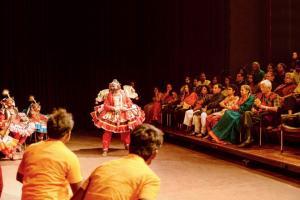How little we know of India and those changing it at the grassroots, is the thought guests at a powerful Tamil heritage theatre performance of Kattaikkuttu went home thinking

C Rajagopal demonstrates to the guests at G5A in Mahalaxmi, how he differentiates between playing Karna in Karna Moksham, and Duryodhana using body language
When Sanjna Kapoor tells an intimate audience at G5A’s Blackbox, “we want your money”, she comes across as anything but opportunistic. She is introducing a session of Junoon Salons, an arts initiative she launched with Sameera Iyengar, supported entirely by patron members. Sanjna is speaking to a group, including some of the city’s most influential across filmmaking, theatre and architecture, who are there to experience a 1.5 hour performance of Kattaikkuttu. The duration is significant because it’s a précis version of an odyssey. The actors and musicians used to performing on gravelly sprawling grounds for eight hours straight through the night are keeping it smooth and short. It’s not something indologist Hanna de Bruin lets anyone forget. But she knows that for an ancient dance form to thrive beyond the village of Punjarasantankal in Tamil Nadu, where it’s practiced at their gurukulam, they must adapt.
All she wants is equal commitment from the audience. She speaks of an indifferent Indian press that “won’t leave Chennai” to write about the state’s mindboggling cultural traditions. How then will anyone know Kattaikkuttu exists? How can they hope to get funding? How will the government be nudged into offering a helping hand to a practice that doesn’t find specific mention in ancient texts but could be 300 years old according to her estimates.
ADVERTISEMENT

Hanna de Bruin says cutting down an eight-hour performance to 1.5 is tough given that actors work on song and oral cues
For 29 years, Hanna and her husband P Rajagopal, have run India’s only mixed-gender Kattaikkuttu company. Women play women. Men play women. Women play men. Men play men. It’s the ultimate expression of casting equality. S Tamiliarasi, a young girl will have you forget her spindly body when she flares her arms as Draupadi, challenging Dushasana as he demands she come with him because Duryodhana wishes to seat her on his lap in an act of humiliation. “She also plays a very good Abhimanyu,” Hanna says, throwing her a smile. It’s clear she’s proud of the young actors’ journey to confidence, the ability to challenge gender and social inequality even if only through a daring game of dice on stage, or the clown’s satire.
Unlike the north, in the Tamil version of the Mahabharata, Draupadi vanquishes Duryodhana when she challenges him to a final game of chaupar. It’s possibly why she is worshipped in the state. Here, she isn’t a mythical queen; she is a goddess. And despite the stark independence her character displays, because originally, Kattaikkuttu performers belonged to the dhobi, barber and pandaram castes, social equilibrium was important to maintain. “They couldn’t offend the upper caste patrons,” Hanna suggests. Yet, over time, writers like Rajagopal have pushed the boundaries, ever so little. While the songs are fixed, every actor has the liberty to improvise with dialogue.
Rajagopal, who writes, directs and acts, comes from a lineage of performers. His father was a well-known actor who ran his own drama company, absorbing his son into the fold at age six. Hanna designs the costumes and ornaments made from light wood of the Indian coral tree, embellished with mirrors and gold paint, that she says give the cast “a superhuman visual appearance”. The stories they tell are from the Mahabharata and Puranas, but hold within them anytime, anywhere wisdom.
As the guests snake out of the audi to the adjoining cafe, the actors scatter around the green room loft, caking off their make-up, an obstinate mix of talcum powder, water and coconut oil. “Did you ever dance?” I ask Hanna, realising she must, given her expressive eyes. “Back in The Netherlands, yes. But it’s been solely administration for the last 30 years,” she says, taking a bite of the Tirunelveli halwa that everyone wants to congratulate chef Amit Jog for. She speaks of the gurukul being more than a sanctuary to protect an art. It also preserves sanity. Several of the young artistes, including children, come from disadvantaged families. Kattaikkuttu Sangam is their retreat — to learn the arts, pursue formal education, stay away from the madness. Kiran Rao comes by to tell Hanna that the evening was mesmerising. She puts down her plate to chat. She doesn’t tell me what dance she danced. Unfinished conversations are opportunities. Perhaps this discussion must finish somewhere else. May be in Punjarasantankal.
Log on to junoonsalons.junoontheatre.org (to explore the Junoon Salons membership); kattaikkuttu.org to know more about Kattaikkuttu Sangam Gurukul
Catch up on all the latest Mumbai news, crime news, current affairs, and also a complete guide on Mumbai from food to things to do and events across the city here. Also download the new mid-day Android and iOS apps to get latest updates
 Subscribe today by clicking the link and stay updated with the latest news!" Click here!
Subscribe today by clicking the link and stay updated with the latest news!" Click here!







